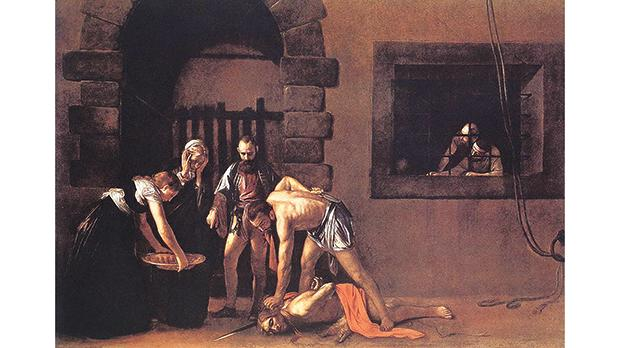The Beheading of Saint John the Baptist
The Beheading of Saint John the Baptist is an oil painting done by an Italian painter Caravaggio to depict the execution of John the Baptist. The painting, which measures 3.7 m by 5.2 m is located at St. John’s Co-Cathedral in Malta. Caravaggio used this piece of art to show a moment of murder that took place in the yard of a prison. The executioner and the people around him are dressed in 17th-century attires. These were not the exact clothing worn in the era when John was actually beheaded. This is a sign that the beheading took place in the 17th century. The themes of indifference and mercy have been elaborately expressed in the painting.
The executioner, the jailor, and one of his women companions as well as two other inmates staring from the window seem impassioned and cold. The other woman is merciful; expressions of pity and fear are written all over her face. She attempts to cover her ears to block John’s screams. There is a sword on the floor but the executioner still reaches out for one seemingly on his waist. This is an indication that the first sword did not do the job perfectly. The second one would ultimately end John’s life. The light effects of the painting as used by Caravaggio put much emphasis on the executioner and John.

Caravaggio uses this painting to, among other things, illustrate his biography. He had fled Italy to Malta after killing a man there. During those days, murderers were punished by death through beheading. He deliberately chose Malta for his escape because he was aware that St. John’s Order was there. He was informed that the Pope was the only person who could forgive him. So, he joined the Order that the Pope attended and offered his painting services. This painting is, therefore, a tribute to the Order by Caravaggio. He signed his name on it using the blood oozing from the neck of John. This is perplexing as it could be providing clues into who killed the Baptist.
The flowing blood of John is almost covering Caravaggio’s name tag. This could be a sign of redemption by the blood. Caravaggio is communicating to his audience that the Order of John the Baptist has saved him from his sin of murder. Underneath John’s cloak, are two legs that resemble a lamb (Micchelli, 2018). The artist is trying to draw parallels between the sacrifices made by John and Jesus Christ, who is the ultimate sacrificial lamb. The white cloth worn by the executioner is similar to that worn during baptism. Caravaggio is trying to pass a message that even murders can be born again and saved.
The painting, thus, carried messages of hope and optimism for humanity. Caravaggio is saying that no amount of sin is unforgivable. This is further illustrated by the cutting of the rope that had been used to tie the Baptist. The rope can no longer bind John to the floor. Instead, it can be used to propel him to God as the other end of the rope hangs towards heaven.
Poem
I stood concealed by a wall, watching
I watched from the window, in horror and disdain
As your executor slit your throat
You screamed in pain but your executioner knew no mercy
Blood oozed from your neck and splashed across
I wiped droplets from my forehead
You refused to die
Your killed drew out a dagger to finish up the work
He had a job to do
Salome wanted to be happy
She witnessed all
She was overjoyed
I wanted to hate your killer
But I was also a killer
I look up to your blood for redemption, so is he
Reference
Micchelli, T. (2018). Caravaggio’s Mark of Madness. Hyperallergic. Web.